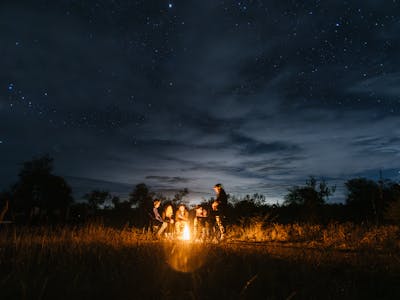
The 'All In' Gap Year Experience
Five weeks. Four projects. One epic adventure that will change your life forever.
Step out of your comfort zone and into the thrilling world of African wildlife conservation - a place full of iconic and endangered species, like-minded travellers from around the world, and teams of inspirational wildlife experts.
Whether you’re providing hands-on care for rescued animals in a wildlife sanctuary, going behind the scenes of a Big 5 reserve, or exploring the famous Greater Kruger area alongside expert field researchers - you’ll get a real 360-degree view of wildlife conservation and discover a side of Africa most travellers never see.
But above all, this is your chance to stand up for some of the planet’s most vulnerable species. To join the frontline of wildlife conservation and make a difference to carefully selected projects in amazing locations that support global organisations like the WWF and Endangered Wildlife Trust (EWT).
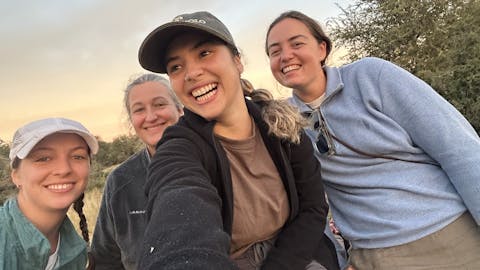
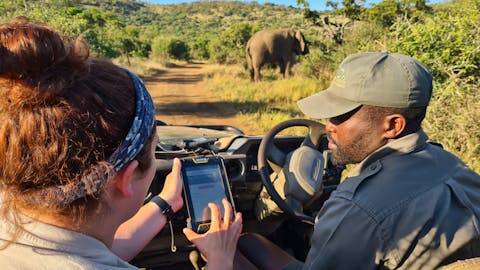
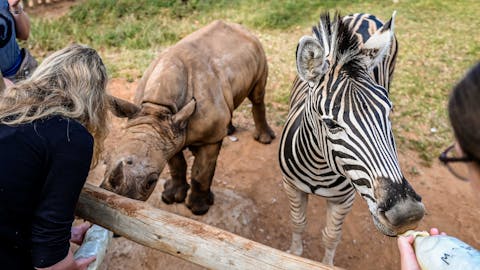
Four projects in one adventure
Wildlife conservation comes in many shapes and sizes - and this is your chance to experience them all. From the world’s largest rhino orphanage and a rehabilitation centre caring for dozens of different species, to one of the largest private reserves in South Africa and a vast wilderness area not accessible to tourists.
Work with iconic and endangered species
You’ll research, monitor and care for a wide variety of animals - including threatened species such as rhinos, lions, cheetahs, wild dogs, honey badgers, servals, bushbabies, vultures and antelope.
Friendly social atmosphere
You’ll join a group of like-minded travellers living on-site at each project. Whether you’re sitting around the campfire, enjoying a wild swimming excursion, or preparing a baby rhino’s milk together, the social atmosphere is all part of the experience - and a great chance to make new lifelong friends.
Real on-the-ground conservation
Roll up your sleeves and get stuck into the everyday work of real wildlife reserves and rehabilitation centres. Feeding, cleaning, tracking, bushcraft and bushwalks - this is meaningful work on the frontline of wildlife conservation.
Witness wildlife management, behind the scenes
You’ll experience life behind the scenes in one of the largest and most successful wildlife conservancies in South Africa - assisting with real tracking, monitoring and game drives most tourists never see, let alone participate in.
Explore South Africa’s wild landscapes
From open savannahs dotted with acacia and baobab trees to rocky bushveld plateaus, red sandstone cliffs and river valleys alive with wildlife, you’ll experience a remarkable range of natural habitats as you travel between conservation projects in northeastern South Africa.
Work side by side with experts
You’ll live and work alongside true wildlife experts, including one of the world’s top rhino specialists and a team of highly qualified ecological monitors. With one-to-one learning opportunities at every turn, you’ll pick up unique conservation insights, straight from the source.
Support global organisations and your CV
Join renowned projects working in partnership with the Endangered Wildlife Trust (EWT), WWF, Panthera and the African Pangolin Working Group. As well as contributing to major global conservation goals, you’ll gain real-world experiences to sharpen your skills - and your CV.
You can book this experience as it is. Or, you can customise it to be just right for you.
- Accommodation
- Airport Meet & Greet
- Internal Flights
- Transfers
- 24/7 Support
- Personal Guidance
- Financial & Legal Protection
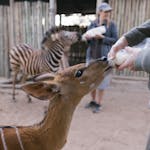
Volunteer at one of the biggest wildlife sanctuaries in South Africa - home to lions, leopards, cheetahs, wild dogs, hyenas, vultures, and many other threatened animals. From preparing enrichment activities to helping maintain enclosures, you’ll get involved with every aspect of animal care and rehabilitation. If you’re lucky, you may even get to experience the moment an animal is safely returned to the wild.
- Meals Provided
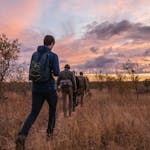
Explore the Greater Kruger Park in a way few others ever do… on foot. Alongside an expert guide, you’ll step into one of the few remaining ecosystems large enough to host a mega population of lions, growing numbers of elephants, plus wild dogs, black and white rhino and other threatened species. Together, you’ll carry out vital practical conservation, monitor iconic species and immerse yourself in the untamed beauty of this UNESCO Biosphere Reserve.
- Meals Provided
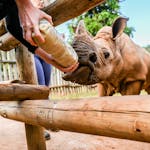
Experience life inside one of the world's largest and most successful rhino sanctuaries. From bottle-feeding orphaned calves to monitoring older rhinos after they’re released into the wild, you’ll work up close with these amazing creatures and gain unique insights into their behaviour and individual personalities.
- Meals Provided
Go behind the scenes in a Big 5 wildlife conservancy where you’ll monitor lions, elephants, rhinos, pangolins and other species in their natural habitats. Part-owned by the local Zulu community, Phinda is a true conservation success story - and plays a vital role in the WWF’s efforts to reintroduce black rhinos across more parts of Africa.
- Food For Meal Preparation Provided
You’ll support the project teams in real hands-on wildlife research and care work. Depending on the conservation priorities at the time, this will include a range of the following activities.
Rehabilitation, care and husbandry
You’ll work with a variety of animals, some who can be rehabilitated and released back into the wild and others who require life-long care in a sanctuary.
You will get to observe or assist:
- Providing animal care and husbandry for orphaned and injured wildlife, including rhinos.
- Preparing and delivering animal feeds, including milk formula, grass, pellets, and species-specific diets.
- Bottle-feeding young animals (such as rhinos), or feeding by other appropriate methods.
- Cleaning enclosures, mucking out, replacing bedding, cleaning water troughs and feeding bottles.
- Enriching animals’ lives through physical exercise, mental stimulation, and creating naturalistic habitats.
- Integrating young or juvenile animals into enclosures or social groups.
You could also observe or assist:
- Creating mud wallows or scratching posts as habitat enrichment for rhinos.
- Preparing and releasing animals into protected reserves.
- Supporting the integration of rhinos into a "crash" (a group of rhinos).
- Game drives in surrounding reserves, offering sightings of animals previously released from the centre.
Caring for young wildlife (seasonal: peak activity from November to March)
Looking after young animals can be particularly rewarding but requires close attention.
You will get to observe or assist:
- Preparing food or milk formula tailored to species-specific needs.
- Bottle-feeding or hand-feeding young animals, especially rhinos.
- Providing regular care, health monitoring, and emotional support.
- Supporting integration of young animals into communal enclosures.
Veterinary nursing
Most animals arrive at centres with injury or trauma. Depending on your skills and the needs of the project, you could support a professional vet or veterinary nurse in treating these new arrivals.
You will get to observe or assist:
- Working in on-site veterinary clinics.
- Dressing wounds, administering treatments, and preparing nutritious diets.
- Monitoring vital signs and doing regular health checks.
- Carrying immobilised animals or assisting in field procedures.
You could also observe:
- Life-saving procedures by specialist wildlife vets.
- Wildlife disease management through vaccines and monitoring.
Wildlife research, monitoring and conservation
This work supports the conservation of rhinos, elephants, predators, and other key species in protected reserves like Greater Kruger and Phinda.
You will get to observe or assist:
- Tracking and monitoring released or wild animals on foot, during bush walks or game drives.
- Recording sightings, mapping movements, and building identification kits (e.g. for rhinos).
- Monitoring social dynamics, population numbers, and behaviour (feeding, breeding, territoriality).
- Identifying individual rhinos and sharing data with anti-poaching teams.
- Managing and maintaining camera traps, and analysing their data.
- Monitoring the activity of elusive species such as hyenas, servals, pangolins, and priority birds.
- Supporting safe feeding zones for wild vultures (e.g. in the Drakensberg Mountains).
- Monitoring prey utilisation by large predators.
You could also observe or assist:
- Using telemetry to track collared wildlife such as elephants and pangolins.
- Bi-annual camera trap surveys.
- Removing invasive plants, clearing bush, and rebuilding damaged fences.
- Helping with practical conservation tasks like habitat preservation, erosion control, or water resource protection.
Wildlife management
Depending on the time of year and needs of the reserve, you may have the opportunity to observe or assist:
- Rhino immobilisation and ear-notching for research and monitoring purposes.
- Humane rhino horn trimming as an anti-poaching measure.
- Release and reintroduction of species like pangolins.
- Contraceptive programmes to manage populations of elephants and predators.
- Administering vaccines to help prevent the spread of wildlife disease.
Community work
In some locations, conservation work is closely tied to community outreach. You could assist with:
- Supporting local children with schoolwork and learning activities.
- Helping with food gardens or other small-scale farming initiatives.
- Participating in job creation or community upliftment efforts.
Additional conservation experiences
These immersive activities will expand your understanding of the ecosystem and the role of conservation.
You will get to:
- Go on guided bush walks with trained rangers or anti-poaching dogs.
- Experience boat trips along the Blyde River Canyon for waterside wildlife viewing.
- Visit other rehabilitation centres partnered with conservation organisations like EWT.
- Join night drives to observe nocturnal wildlife such as leopards, hyenas, porcupines, and bushbabies.
- Take an optional excursion to Kruger National Park (subject to availability and additional cost).
You’ll learn about animal husbandry, wildlife behaviour, biology, ecology, and conservation issues. Depending on the projects’ work at the time, this will include a range of the following topics.
Animal husbandry
- How to plan and prepare species-specific diets (milk formula, grass, pellets, browse) and provide fresh water.
- Best-practice hygiene: cleaning, disinfecting, mucking out and waste removal.
- How to monitor the health and behaviour of captive animals, spotting early signs of stress or illness.
- Stabilising and integrating new arrivals - especially orphaned rhinos - into existing enclosures or social groups.
Behaviour
- Natural and captive behaviours of African wildlife, including prides of lions, elephant and buffalo herds, antelope groups, and rhino "crashes."
- Predator–prey dynamics and hunting strategies: social predators (lions, hyenas, wild dogs) vs. solitary hunters (leopards, cheetahs).
- Communication signals and social interactions among rhinos and other species.
- Enrichment techniques that provide mental stimulation and emotional well-being for animals in care.
- Breeding, mating and rearing behaviour of the Big 5 and other African species.
- Movement patterns of large herds and elusive species such as leopards.
Biology
- Physiology and natural diets of predators (lion, leopard, hyena), rhinos (white vs. black), and the wider Big 5.
- Reproductive biology and parental care across different species.
- Recognising male vs. female animals and understanding group structure.
- Optimum captive environments that meet each species’ biological needs.
- Native African flora and smaller fauna (reptiles, amphibians, birds, insects).
Ecology
- Natural habitats of the species you’ll work with and their ecological roles.
- Rhinos as an umbrella species and keystone predators’ impact on ecosystem balance.
- Effects of population growth or decline (e.g. elephants, lions) on habitat health.
- Unique ecosystems - from Phinda’s sand forest to UNESCO-listed landscapes - and the areas’ geology, trees and birds.
- Why large continuous reserves outperform fragmented ones, and the main threats facing African ecosystems today.
Conservation
- Human–wildlife conflict: causes, community solutions and anti-predation measures.
- Rhino poaching crisis, rescue operations and orphan-calf rehabilitation.
- Poaching methods (snares, poisoning) and field anti-poaching techniques, including ranger units and dogs.
- Priority-species monitoring: ID kits, telemetry, camera traps and GPS.
- Metapopulation management, translocations and range-expansion projects (e.g. black rhino, cheetah).
- Role of rehabilitation centres and sanctuaries in broader conservation.
- Funding models, the significance of Greater Kruger, and other protected-area networks.
Community engagement
- Phinda’s part-ownership model and other initiatives that link conservation with local livelihoods.
- Supporting schools, food gardens and job creation in neighbouring communities.
Bush skills
- Tracking and approaching wildlife safely on foot.
- Identifying tracks, calls, insects, reptiles and birds.
- Using a spotlight responsibly on night drives.
- Traditional and medicinal uses of indigenous plants and trees.
Educational talks
- Southern-hemisphere astronomy.
- Debates on hunting in conservation.
- Wildlife poisoning and the muti (traditional-medicine) trade.
- Drought impacts in Greater Kruger and adaptive management strategies.




